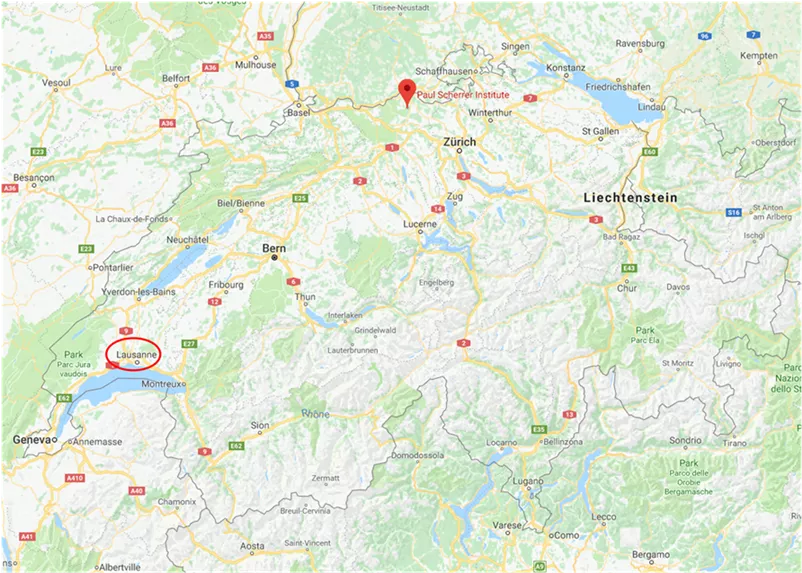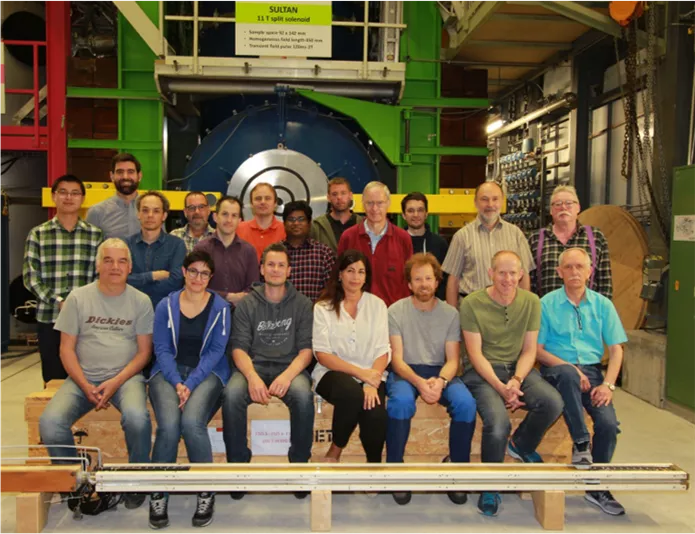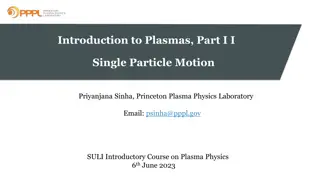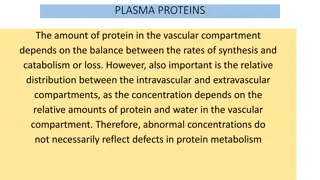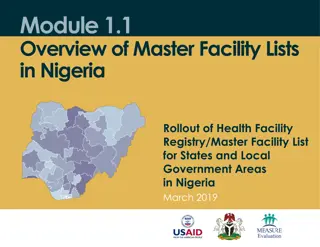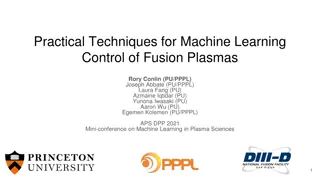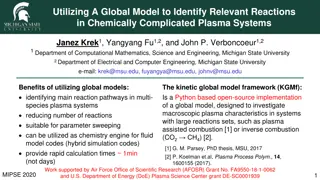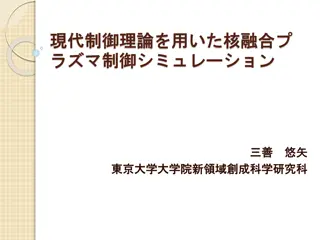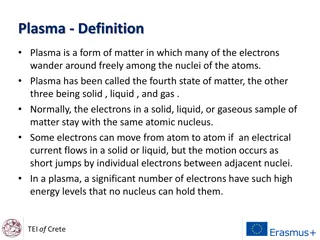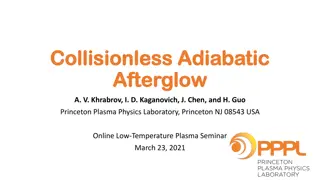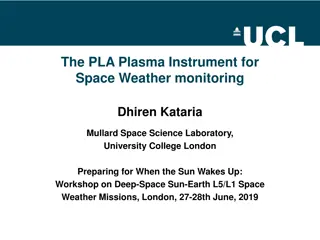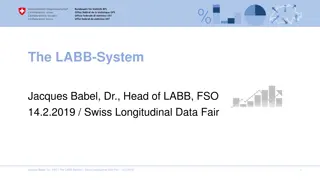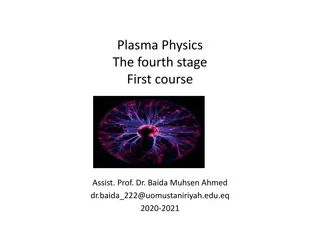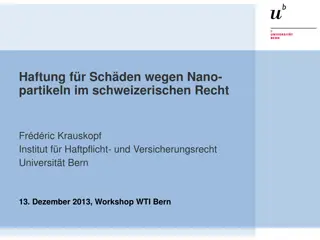The EDIPO2 Test Facility at Swiss Plasma Center
The Swiss Plasma Center at cole Polytechnique Fdrale de Lausanne (EPFL) houses the Superconductivity Group responsible for testing superconductor samples for projects like ITER, DTT, and DEMO. The facility comprises two test facilities, SULTAN & EDIPO, and engages in activities like developing conductors and joints for DEMO magnets. The EDIPO accident report details an incident in May 2016 related to voltage development in a coil.
Download Presentation

Please find below an Image/Link to download the presentation.
The content on the website is provided AS IS for your information and personal use only. It may not be sold, licensed, or shared on other websites without obtaining consent from the author. Download presentation by click this link. If you encounter any issues during the download, it is possible that the publisher has removed the file from their server.
E N D
Presentation Transcript
Status of the EDIPO2 Status of the EDIPO2 Test Facility Test Facility X. Sarasola H. Bajas N. Bykovskiy K. Sedlak P. Bruzzone April 25th, 2023
Swiss Plasma Center Swiss Plasma Center 2 2 X. Sarasola The Swiss Plasma Center (SPC) belongs to the cole Polytechnique F d rale de Lausanne (EPFL) The main site of EPFL-SPC is the campus of Lausanne However, the Superconductivity Group is located in the premises of the Paul Scherrer Institute (PSI) Paul Scherrer Institute
The TheSuperconductivity SuperconductivityGroup Groupof EPFL of EPFL- -SPC SPC 3 3 21 members: 10 scientists + 2 PhD students 5 technicians + 3 operators 1 secretary 2 test facilities: SULTAN & EDIPO Main activities: Test of superconductor samples and joints, mainly for ITER, but also for DEMO, JT60-SA, DTT, CFETR, BEST and SPARC Tests of sub-sized coils and joints for accelerator magnets (CERN) Development of conductors and joints for DEMO magnets Other projects: current leads, R&D on HTS magnets, EDIPO2 STATUS OF EDIPO2 May 2018
Outline Outline 4 4 X. Sarasola The EDIPO accident Motivation, design targets and boundary conditions The baseline magnet design: Magneto-static design Quench protection Mechanical analysis Alternative magnet design Other activities: Helium vessel Cable qualification Conclusions and outlook STATUS OF EDIPO2
Outline Outline 5 5 X. Sarasola The EDIPO accident Motivation, design targets and boundary conditions The baseline magnet design: Magneto-static design Quench protection Mechanical analysis Alternative magnet design Other activities: Helium vessel Cable qualification Conclusions and outlook STATUS OF EDIPO2
The EDIPO The EDIPO accident accident 6 6 X. Sarasola On May 31st2016 voltage developed in Double Layer #6 of coil #1. After 0.5 s, the voltage in DL6 reached the 100 mV threshold and the quench flag went up. In normal circumstances, it takes ~20 ms for the breakers to open, however on May 31st2016 it took 3.15 s. July 2013 May 31st, 2016 STATUS OF EDIPO2
The EDIPO The EDIPO accident accident 7 7 X. Sarasola The delayed opening of the breakers was not accidental. It was the result of the malicious manipulation of the quench detection software. A timer (set at 5 s) and a comparator of the operating current (set for >80%*Iop) were inserted to delay the signal for opening the breakers. Original Manipulated STATUS OF EDIPO2
The EDIPO The EDIPO accident accident 8 8 X. Sarasola The overheating of the conductor at the quench location (estimated up to 300 C) caused the thermo-mechanical failure and softening of the electrical insulation. The damaged insulation didn t withstand the high voltage (1.7 kV) when the breaker opened. An arc to ground developed and a large fraction of the stored energy (16 MJ) was dissipated in the arc. The coil assembly was fully impregnated and not designed to be disassembled No repair action is possible STATUS OF EDIPO2
Outline Outline 9 9 X. Sarasola The EDIPO accident Motivation, design targets and boundary conditions The baseline magnet design: Magneto-static design Quench protection Mechanical analysis Alternative magnet design Other activities: Helium vessel Cable qualification Conclusions and outlook STATUS OF EDIPO2
Motivation and design targets Motivation and design targets In the last 20 years, all major superconducting fusion facilities worldwide have qualified their conductors in SULTAN: ITER, JT60-SA, SPARC, BEST, CFETR, DTT, and the EU-DEMO There is a growing demand towards: High current conductors (close to 100 kA) Conductors for high field magnets (partly driven by the development of HTS) 10 10 X. Sarasola SULTAN (SPC) 10.9 EDIPO (SPC) 12.35 FRESCA2 (CERN) 14.6 EDIPO 2 Units Bcenter aperture Aperture size 15 T 94 144 90 141 100 144 144 mm Homogeneous field length (1%) 320 680 540 1000 mm STATUS OF EDIPO2 Sample current Sample operating temperature 32 kA K 100 100 100 4.5 to 50 4.5 to 50 1.9 & 4.2 4.5 to 50
Boundary conditions Boundary conditions 11 11 X. Sarasola Given by the existing facility: Maximum dimensions of magnet assembly: Diameter 1320 mm Length 2500 mm Overall assembly weight 20 t (overhead crane) Operating current 18 kA (existing power supply) Other assumptions: Operating temperature: 4.2 K (liquid He bath) Nominal field reached at 85% of short sample Dump voltage to ground 1 kV (symmetric grounding) Allowable coil hot spot temperature: ~300 K ~2500 STATUS OF EDIPO2
Boundary conditions Boundary conditions 12 12 X. Sarasola Given by the existing facility: Maximum dimensions of magnet assembly: Diameter 1320 mm Length 2500 mm Overall assembly weight 20 t (overhead crane) Operating current 18 kA (existing power supply) Other assumptions: Operating temperature: 4.2 K (liquid He bath) Nominal field reached at 85% of short sample Dump voltage to ground 1 kV (symmetric grounding) Allowable coil hot spot temperature: ~300 K STATUS OF EDIPO2
Outline Outline 13 13 X. Sarasola The EDIPO accident Motivation, design targets and boundary conditions The baseline magnet design: Magneto-static design Quench protection Mechanical analysis Alternative magnet designs Other activities: Helium vessel Cable qualification Conclusions and outlook STATUS OF EDIPO2
EDIPO 2: Magnet design EDIPO 2: Magnet design 14 14 X. Sarasola Accelerator-type magnet: Flared-end block coil design Shell-based mechanical structure: Outer shell made of steel Adjustable pre-compression Use of detachable winding poles Unlike accelerator magnets, the field quality of the generated background field is not a crucial design target in a test facility 4 and 6-coil designs are considered (purely rectangular winding pack: windings aligned in low and high field side) STATUS OF EDIPO2
Cable design Cable design 15 15 X. Sarasola Rutherford cable considered until 2020 (44 1.1 mm FCC strands): Ioplimited to ~10.6 kA One of the largest aspect ratio Rutherford cables ever built (quite stiff) A two-stage cable layout can operate at a current closer to 18 kA and might result in a more flexible design. STATUS OF EDIPO2
Magnet design: Magnet design: Magnetostatic Magnetostatic3D model 3D model 16 16 Our first model in LEDET has been validated against the latest quench analysis performed in the previous baseline: 6 coil design FCC cable Iop= 14.1 kA Number of turns per pancake, npan 4-coil design 6-coil design Units 4-coil design Cable layout 26 (6+1) 22 (6+1) Total area of insulated conductor 30538 25254 mm2 Operating current, Iop(85% Iss) 17.12 17.37 kA B field in the center of the aperture, Bcenter 15.11 15.10 T Peak B field in the coils, Bpeak 16.30 15.83 T 37 24 Results for the comparison taken from E. Ravioli s presentation of Nov 22nd, 2019 Total magnet stored energy, Etotal Total number of turns, ntotal 296 288 6-coil design Total ampere-turns, Itotal 5.07 5.00 MAt 13.5 12.0 MJ STATUS OF EDIPO2 Magnet self-inductance, L 92.1 79.5 mH Engineering current density, jeng 165.9 198.1 A/mm2 Copper current density, jCu 488.9 586.2 A/mm2
4 4- -coil design: 2D vs 3D. Field quality coil design: 2D vs 3D. Field quality 17 17 X. Sarasola Magnetic 3D model Magnetic 2D model STATUS OF EDIPO2
4 4- -coil design: 2D vs 3D. Field quality coil design: 2D vs 3D. Field quality 18 18 X. Sarasola Good agreement between 2D and 3D models: Uniformity along x and y axis: -7% / +5% Uniformity around a circumference of Rref= 40 mm: 2% STATUS OF EDIPO2
4 4- -coil design: 2D vs 3D. Field quality coil design: 2D vs 3D. Field quality 19 19 X. Sarasola Uniform field length along z axis: L = 2 479.3 mm = 958.6 mm STATUS OF EDIPO2
Outline Outline 20 20 X. Sarasola The EDIPO accident Motivation, design targets and boundary conditions The baseline magnet design: Magneto-static design Quench protection Mechanical analysis Alternative magnet design Other activities: Helium vessel Cable qualification Conclusions and outlook STATUS OF EDIPO2
Simulation of Simulation of two two- -stage stage cables cables in LEDET in LEDET 21 21 X. Sarasola Two approaches were used: 1. Simulation of 22 sub-cables of equivalent cross-section (1.85 mm diameter) 2. Simulation of the actual cable: 22 (6+1) 0.7 mm diam. The magnetic field had to be interpolated at the center of each of the 154 strands. Inter-strand coupling losses (ISCL) in two stage cables are not precisely simulated The additional resolution (and computation time) didn t change the results Approx. 1 Approx. 2 STATUS OF EDIPO2
Assumptions Assumptions 22 22 X. Sarasola Simulations performed with STEAM-LEDET [1], [2] (v1.08.03) 2D model Energy extraction protection scheme: Quench detection + validation time: 15 ms Energy extraction triggering time: 1 ms Cu:nCu: 1.0 Nominal Parametric variation RRR 100 100 - 300 Filament twist-pitch 14 mm 10 - 30 mm Effective transverse resistivity factor 1 0.5 - 2 STATUS OF EDIPO2 [1] E. Ravaioli, CLIQ , PhD thesis, 2015 [2] E. Ravaioli et al., Cryogenics 2016 https://cern.ch/steam/LEDET/
Hot spot temperature: 4 coils vs 6 coils designs Hot spot temperature: 4 coils vs 6 coils designs Protection based on energy extraction should work (even without interfilametary coupling currents) 23 23 X. Sarasola STATUS OF EDIPO2
Outline Outline 24 24 X. Sarasola The EDIPO accident Motivation, design targets and boundary conditions The baseline magnet design: Magneto-static design Quench protection Mechanical analysis Alternative magnet design Other activities: Helium vessel Cable qualification Conclusions and outlook STATUS OF EDIPO2
Mechanical design Mechanical design 25 25 X. Sarasola Pre-compression can be adjusted, but it is kept at a minimum level Outer shell is made of steel Coils are allowed to detach from the test well during operation Use of detachable winding poles The test well is stress-free during operation STATUS OF EDIPO2
Mechanical design Mechanical design 26 26 X. Sarasola The coils are essentially stress-free during insertion of the keys at room temperature and after cool-down The von Misses stress in the coils is always below 121 MPa (<80 MPa in the high field region) A gap of <1.5 mm opens between coils and test well during operation Stress in the test well: Moderate during key insertion and cool-down Stress-free during operation STATUS OF EDIPO2
Displacement and stress in the coil ends (3D) Displacement and stress in the coil ends (3D) Displacement 27 27 X. Sarasola Equivalent stress Cool-down Cool-down Nominal field Nominal field STATUS OF EDIPO2
Possible solution: end spacers Possible solution: end spacers 28 28 X. Sarasola The equivalent stress in the coils at nominal field is reduced by the use of end spacers, but it remains above 200 MPa Sliding contact between coil and end spacers Baseline: No end spacers 1 block: 37 turns Straight section: 960 mm Peak eqv= 454 MPa Option 2: 2 60 mm spacers 3 blocks: 1+2+34 turns Straight section: 734 mm Peak eqv= 342 MPa Option 1: 2 30 mm spacers 3 blocks: 2+2+33 turns Straight section: 847 mm Peak eqv= 333 MPa STATUS OF EDIPO2
3D magnetic model 3D magnetic model 29 29 X. Sarasola Unfortunately, lowering the field at the ends comes at the expense of reducing the uniform field length STATUS OF EDIPO2
Outline Outline 30 30 X. Sarasola The EDIPO accident Motivation, design targets and boundary conditions The baseline magnet design: Magneto-static design Quench protection Mechanical analysis Alternative magnet design Other activities: Helium vessel Cable qualification Conclusions and outlook STATUS OF EDIPO2
Alternative design Alternative design 31 31 X. Sarasola Magnet design purely based on racetrack coils: It may simplify the manufacturing (planar coils) It might simplify the management of mechanical stress It requires a larger cross-section of superconductor Field quality will be worse but acceptable for a test facility STATUS OF EDIPO2
Alternative design Alternative design 32 32 X. Sarasola We may consider the use of REBCO STATUS OF EDIPO2
Outline Outline 33 33 X. Sarasola The EDIPO accident Motivation, design targets and boundary conditions The baseline magnet design: Magneto-static design Quench protection Mechanical analysis Alternative magnet design Other activities: Helium vessel Cable qualification Conclusions and outlook STATUS OF EDIPO2
Liquid helium vessel Liquid helium vessel 34 34 X. Sarasola The EDIPO 2 magnet will be bath-cooled at 4.2 K. Three main parts of the helium vessel: Bottom base (interface with the existing facility) Cylindrical body Lid (not final design) Main parameters: Operating pressure: 1 bar Accident pressure: 3 bar Leak rate < 10-8mbar l/ s STATUS OF EDIPO2
Liquid helium vessel Liquid helium vessel 35 35 X. Sarasola The EDIPO 2 magnet will be bath-cooled at 4.2 K. Three main parts of the helium vessel: Bottom base (interface with the existing facility) Cylindrical body Lid (not final design) Main parameters: Operating pressure: 1 bar Accident pressure: 3 bar Leak rate < 10-8mbar l/ s During 2021 a Swiss company has manufactured the vessel. It was delivered at SPC in December 2021. STATUS OF EDIPO2
Cabling and winding trials Cabling and winding trials 36 36 X. Sarasola 105 kg of high-jcstrand (>2200 A/mm2at 12T and 4.2 K) have been purchased Cabling trials will follow 25.9 mm 3.48 mm Ultimately, the goal is to produce a prototype coil and test it in SULTAN STATUS OF EDIPO2
Outline Outline 37 37 X. Sarasola The EDIPO accident Motivation, design targets and boundary conditions The baseline magnet design: Magneto-static design Quench protection Mechanical analysis Alternative magnet design Other activities: Helium vessel Cable qualification Conclusions and outlook STATUS OF EDIPO2
Conclusions and outlook Conclusions and outlook Magnet design: Distinctive features of EDIPO2: 15 T in a 144 144 mm2aperture. Use of a two-stage cable design. The stress in the coil ends is a critical aspect of the baseline design. Other aspects of the design satisfy the stringent criteria to generate a background field of 15 T in a large aperture. Design efforts are concentrated on: Reduction of the mechanical stress in the coil ends Simplification from the manufacturing point view (racetrack coils) He vessel has been manufactured and delivered. 105 kg of high-jcstrand have been purchased for cabling and winding trials Funding approved by the ETH board (2025-2028) 38 38 X. Sarasola STATUS OF EDIPO2
We are hiring We are hiring 39 39 X. Sarasola Postdoc: EDIPO2 https://www.psi.ch/en/pa/job-opportunities/56605-post-doctoral-researcher-epfl Postdoc: DEMO (+ EDIPO2) https://www.psi.ch/en/pa/job-opportunities/56602-post-doctoral-researcher-epfl PhD student: EDIPO2 https://www.psi.ch/en/pa/job-opportunities/56608-phd-student-in-applied- superconductivity-epfl Join our team! STATUS OF EDIPO2
40 40 X. Sarasola Thanks for your attention! STATUS OF EDIPO2
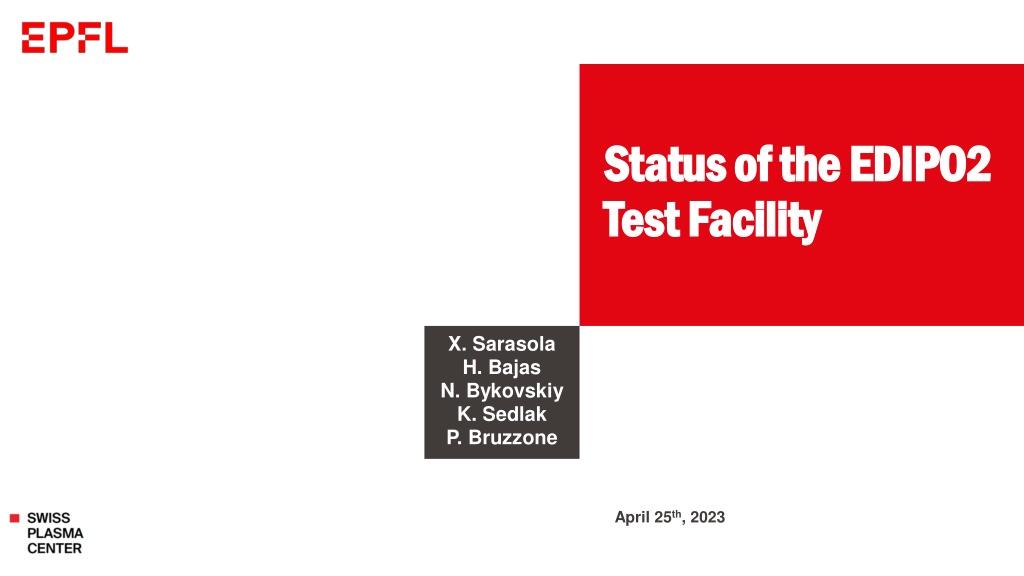
 undefined
undefined







